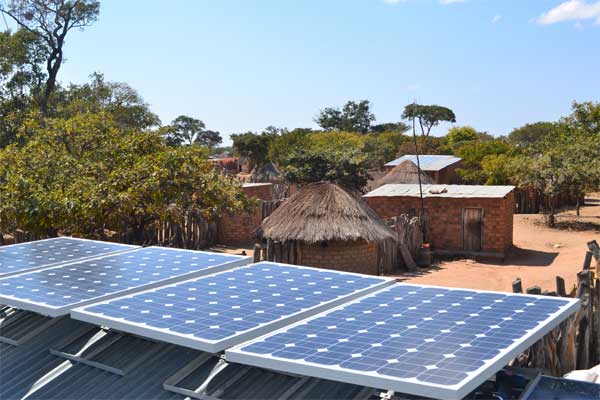Clean Energy for the Developing World
As the cost of solar panels and batteries continues to fall, the potential for renewable energy to raise the standard of living in the developing world is becoming a reality. For those of us with air conditioning and Pokemon Go, it may be hard to imagine that nearly one quarter of the world’s population lives without access to electricity.
Developing a centralized electricity grid is a massive undertaking that may never be economically feasible for many developing nations. But solar and energy storage technologies are enabling the creation of distributed renewable energy systems, giving power to people in remote areas where it was previously not possible.
Distributed renewable energy systems can range in size. Large microgrids can power entire towns. Smaller microgrids, such as Aquion’s recent installation in Loisaba Conservancy in Kenya, can power commercial sites such as hotels. Systems consisting of just a few solar panels and batteries for a single home provide power for lighting, cell phones, laptops, and small electric cooktops at night.
Remote electrification projects with these small, residential solar and energy storage systems could immediately improve the lives of the nearly 1.3 billion people living in places like sub-Saharan Africa, where nearly two-thirds of the population have virtually no access to electricity today.
Just a few extra hours of lighting and power for small appliances can provide more access to education for children and allow businesses to operate more efficiently for longer hours, helping to break the cycle of poverty and promote economic growth.
Just How Clean is Your Energy?
Renewable energy systems reduce or eliminate the cost, logistical complexity, and environmental impact of using diesel fuel, factors that are especially acute in remote or rural electrification projects. However, the components of renewable energy systems have their own material health risks.
Most renewable energy systems in these areas today use solar panels and lead acid batteries. Many solar installers are familiar with lead acid batteries, which can be easily sourced worldwide. But they’re not the most long-lived in solar applications, particularly in hot climates, that don’t regularly let the batteries fully charge –see our blog post for more on the limitations of deep cycling lead acid batteries. What happens to these batteries in a year or two, when they need to be replaced?
While major lead acid battery manufacturers have built an extensive recycling infrastructure, it doesn’t necessarily reach into the developing world. In fact, the practice of informal lead acid battery recycling has been identified as a serious public health issue for developing nations. A report from the Green Cross and Blacksmith Institute, for instance, compares the impact of improper lead acid battery recycling and lead smelting to that of malaria and HIV/AIDS in developing nations.
The primary source of informally recycled lead acid batteries is cars, which there are very few of per capita in Africa. When you consider the hundreds of millions of lead acid batteries that would be required for electrification projects, the potential scale of the public health risk increases dramatically.
It’s nice to think that project developers committed to improving the lives of people living in developing countries will account for end-of-life battery disposal and recycling. But the simple fact is that people in the developing world are often not aware of, or are skeptical of, the health risks associated with handling lead.
Many people trying to make a subsistence living see lead from spent batteries as a valuable resource. It’s often difficult to convince people with few economic options to find another source of income, especially because many of the detrimental health effects of lead can take years to manifest.
Even lead acid battery recycling plants in the United States have had their share of problems. Recenly, such a plant outside of Los Angeles was forced to close following years of environmental regulation violations and complaints from residents. When the materials that go into your batteries are highly toxic, extracting and recycling those materials without creating other health risks can be quite challenging.
What’s the Alternative?
The other most widespread battery chemistry for renewable energy applications, lithium ion, faces its own disposal and recycling challenges, particularly due to its flammability and potential to release of hydrogen fluoride, a highly toxic gas.
These end-of-life considerations were central to the development of Aquion’s unique, environmentally sustainable battery chemistry. As the hazards of rising CO2 emissions and their impact on global warming have taught us, we must consider the entire lifecycle of an energy system, from the raw materials, to its manufacturing process, use, and ultimately disposal at the end of its life. Otherwise we’re creating problems further down the road.
Aquion’s Aqueous Hybrid Ion (AHI™) chemistry is unique in that none of its components are environmentally hazardous. Our batteries can be recycled, but they can also be disposed of as normal, non-hazardous waste, in situations where recycling isn’t practical–as is the case in developing nations that benefit most from distributed renewable energy. Aquion makes the only battery in the world that’s Cradle to Cradle Certified™, a recognition of the sustainability of the product’s entire manufacturing and disposal process.
In addition, Aquion batteries are a great choice for distributed energy in remote areas.The AHI chemistry isn’t impacted by high temperatures or partial state of charge cycling, meaning they’re an ideal fit for systems in warm climates, like Africa, and systems where it’s impractical to add a generator to fully charge the batteries after a few days of poor solar production.













Comments